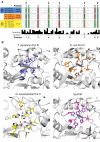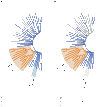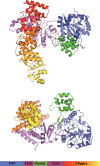A structural role for the PHP domain in E. coli DNA polymerase III
- PMID: 23672456
- PMCID: PMC3666897
- DOI: 10.1186/1472-6807-13-8
A structural role for the PHP domain in E. coli DNA polymerase III
Abstract
Background: In addition to the core catalytic machinery, bacterial replicative DNA polymerases contain a Polymerase and Histidinol Phosphatase (PHP) domain whose function is not entirely understood. The PHP domains of some bacterial replicases are active metal-dependent nucleases that may play a role in proofreading. In E. coli DNA polymerase III, however, the PHP domain has lost several metal-coordinating residues and is likely to be catalytically inactive.
Results: Genomic searches show that the loss of metal-coordinating residues in polymerase PHP domains is likely to have coevolved with the presence of a separate proofreading exonuclease that works with the polymerase. Although the E. coli Pol III PHP domain has lost metal-coordinating residues, the structure of the domain has been conserved to a remarkable degree when compared to that of metal-binding PHP domains. This is demonstrated by our ability to restore metal binding with only three point mutations, as confirmed by the metal-bound crystal structure of this mutant determined at 2.9 Å resolution. We also show that Pol III, a large multi-domain protein, unfolds cooperatively and that mutations in the degenerate metal-binding site of the PHP domain decrease the overall stability of Pol III and reduce its activity.
Conclusions: While the presence of a PHP domain in replicative bacterial polymerases is strictly conserved, its ability to coordinate metals and to perform proofreading exonuclease activity is not, suggesting additional non-enzymatic roles for the domain. Our results show that the PHP domain is a major structural element in Pol III and its integrity modulates both the stability and activity of the polymerase.
Figures







References
-
- Kornberg A, Baker TA. DNA Replication. 2. W. H: Freeman; 1992.
Publication types
MeSH terms
Substances
Associated data
- Actions
Grants and funding
LinkOut - more resources
Full Text Sources
Other Literature Sources

